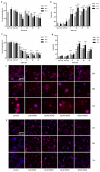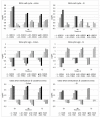Unravelling Mechanisms of Doxorubicin-Induced Toxicity in 3D Human Intestinal Organoids
- PMID: 35163210
- PMCID: PMC8836276
- DOI: 10.3390/ijms23031286
Unravelling Mechanisms of Doxorubicin-Induced Toxicity in 3D Human Intestinal Organoids
Abstract
Doxorubicin is widely used in the treatment of different cancers, and its side effects can be severe in many tissues, including the intestines. Symptoms such as diarrhoea and abdominal pain caused by intestinal inflammation lead to the interruption of chemotherapy. Nevertheless, the molecular mechanisms associated with doxorubicin intestinal toxicity have been poorly explored. This study aims to investigate such mechanisms by exposing 3D small intestine and colon organoids to doxorubicin and to evaluate transcriptomic responses in relation to viability and apoptosis as physiological endpoints. The in vitro concentrations and dosing regimens of doxorubicin were selected based on physiologically based pharmacokinetic model simulations of treatment regimens recommended for cancer patients. Cytotoxicity and cell morphology were evaluated as well as gene expression and biological pathways affected by doxorubicin. In both types of organoids, cell cycle, the p53 signalling pathway, and oxidative stress were the most affected pathways. However, significant differences between colon and SI organoids were evident, particularly in essential metabolic pathways. Short time-series expression miner was used to further explore temporal changes in gene profiles, which identified distinct tissue responses. Finally, in silico proteomics revealed important proteins involved in doxorubicin metabolism and cellular processes that were in line with the transcriptomic responses, including cell cycle and senescence, transport of molecules, and mitochondria impairment. This study provides new insight into doxorubicin-induced effects on the gene expression levels in the intestines. Currently, we are exploring the potential use of these data in establishing quantitative systems toxicology models for the prediction of drug-induced gastrointestinal toxicity.
Keywords: doxorubicin; human organoid models; molecular mechanisms; toxicity; transcriptomics.
Conflict of interest statement
The authors declare no conflict of interest. The funders had no role in the design of the study; in the collection, analyses, or interpretation of data; in the writing of the manuscript, or in the decision to publish the results.
Figures






Similar articles
-
New insights into the mechanisms underlying 5-fluorouracil-induced intestinal toxicity based on transcriptomic and metabolomic responses in human intestinal organoids.Arch Toxicol. 2021 Aug;95(8):2691-2718. doi: 10.1007/s00204-021-03092-2. Epub 2021 Jun 20. Arch Toxicol. 2021. PMID: 34151400 Free PMC article.
-
A Transcriptomic Approach to Elucidate the Mechanisms of Gefitinib-Induced Toxicity in Healthy Human Intestinal Organoids.Int J Mol Sci. 2022 Feb 17;23(4):2213. doi: 10.3390/ijms23042213. Int J Mol Sci. 2022. PMID: 35216325 Free PMC article.
-
Development of Sheep Intestinal Organoids for Studying Deoxynivalenol-Induced Toxicity.Int J Mol Sci. 2025 Jan 23;26(3):955. doi: 10.3390/ijms26030955. Int J Mol Sci. 2025. PMID: 39940725 Free PMC article.
-
Development of intestinal organoids and microphysiological systems and their application to drug discovery.Drug Metab Pharmacokinet. 2025 Feb;60:101045. doi: 10.1016/j.dmpk.2024.101045. Epub 2024 Dec 12. Drug Metab Pharmacokinet. 2025. PMID: 39847977 Review.
-
In Vivo Intestinal Research Using Organoid Transplantation.Keio J Med. 2022 Dec 25;71(4):73-81. doi: 10.2302/kjm.2022-0019-IR. Epub 2022 Dec 1. Keio J Med. 2022. PMID: 36450523 Review.
Cited by
-
Lgr5 + intestinal stem cells are required for organoid survival after genotoxic injury.Development. 2024 Dec 1;151(23):dev202941. doi: 10.1242/dev.202941. Epub 2024 Nov 29. Development. 2024. PMID: 39503201
-
Organoid-Guided Precision Medicine: From Bench to Bedside.MedComm (2020). 2025 May 1;6(5):e70195. doi: 10.1002/mco2.70195. eCollection 2025 May. MedComm (2020). 2025. PMID: 40321594 Free PMC article. Review.
-
The Potential Role of Connexins in the Pathogenesis of Atherosclerosis.Int J Mol Sci. 2023 Jan 30;24(3):2600. doi: 10.3390/ijms24032600. Int J Mol Sci. 2023. PMID: 36768920 Free PMC article. Review.
-
A proof-of-concept assay for quantitative and optical assessment of drug-induced toxicity in renal organoids.Sci Rep. 2023 Apr 15;13(1):6167. doi: 10.1038/s41598-023-33110-5. Sci Rep. 2023. PMID: 37061575 Free PMC article. Review.
-
Applications of 3D organoids in toxicological studies: a comprehensive analysis based on bibliometrics and advances in toxicological mechanisms.Arch Toxicol. 2024 Aug;98(8):2309-2330. doi: 10.1007/s00204-024-03777-4. Epub 2024 May 28. Arch Toxicol. 2024. PMID: 38806717 Review.
References
MeSH terms
Substances
Grants and funding
LinkOut - more resources
Full Text Sources
Research Materials
Miscellaneous

